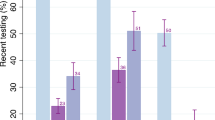Abstract
Unsupervised HIV self-testing (HST) has potential to increase knowledge of HIV status; however, its accuracy is unknown. To estimate the accuracy of unsupervised HST in field settings in Uganda, we performed a non-blinded, randomized controlled, non-inferiority trial of unsupervised compared with supervised HST among selected high HIV risk fisherfolk (22.1 % HIV Prevalence) in three fishing villages in Uganda between July and September 2013. The study enrolled 246 participants and randomized them in a 1:1 ratio to unsupervised HST or provider-supervised HST. In an intent-to-treat analysis, the HST sensitivity was 90 % in the unsupervised arm and 100 % among the provider-supervised, yielding a difference 0f −10 % (90 % CI −21, 1 %); non-inferiority was not shown. In a per protocol analysis, the difference in sensitivity was −5.6 % (90 % CI −14.4, 3.3 %) and did show non-inferiority. We conclude that unsupervised HST is feasible in rural Africa and may be non-inferior to provider-supervised HST.


Similar content being viewed by others
References
UNAIDS. UNAIDS report on the Global AIDS epidemic 2013. 2013.
Bajunirwe F, Muzoora M. Barriers to the implementation of programs for the prevention of mother-to-child transmission of HIV: a cross-sectional survey in rural and urban Uganda. AIDS Res Ther. 2005;2(1):10.
Mugisha E, van Rensburg GH, Potgieter E. Factors influencing utilization of voluntary counseling and testing service in Kasenyi fishing community in Uganda. JANAC. 2010;21(6):503–11.
Wanyenze RK, Kamya MR, Fatch R, Mayanja-Kizza H, Baveewo S, Sawires S, et al. Missed opportunities for HIV testing and late-stage diagnosis among HIV-infected patients in Uganda. PLoS ONE. 2011;6(7):e21794.
Choko AT, Desmond N, Webb EL, Chavula K, Napierala-Mavedzenge S, Gaydos CA, et al. The uptake and accuracy of oral kits for HIV self-testing in high HIV prevalence setting: a cross-sectional feasibility study in Blantyre, Malawi. PLoS Med. 2011;8(10):e1001102.
Spielberg F, Levine RO, Weaver M. Self-testing for HIV: a new option for HIV prevention? Lancet Infect Dis. 2004;4(10):640–6.
Asiki G, Mpendo J, Abaasa A, Agaba C, Nanvubya A, Nielsen L, et al. HIV and syphilis prevalence and associated risk factors among fishing communities of Lake Victoria, Uganda. Sex Transm Infect. 2011;87(6):511–5.
Seeley J, Nakiyingi-Miiro J, Kamali A, Mpendo J, Asiki G, Abaasa A, et al. High HIV incidence and socio-behavioral risk patterns in fishing communities on the shores of Lake Victoria, Uganda. Sex Transm Dis. 2012;39(6):433–9 Epub 2012/05/18.
Kiwanuka N, Ssetaala A, Mpendo J, Wambuzi M, Nanvubya A, Sigirenda S, et al. High HIV-1 prevalence, risk behaviours, and willingness to participate in HIV vaccine trials in fishing communities on Lake Victoria, Uganda, 2013.
Kalibala STW, Muraah TW, Cherutich P, Oweya E, Oluoch P. ‘Knowing myself first’: feasibility of self-testing among health workers in Kenya. Nairobi: The Population Council Inc; 2011.
Napierala Mavedzenge S, Baggaley R, Corbett EL. A review of self-testing for HIV: research and policy priorities in a new era of HIV prevention. Clin Infect Dis. 2013;57(1):126–38.
Lemke MR, Mendonca RJ. A question of accessibility: understanding lay users of medical devices. Biomedical Instrumentation & Technology/Association For The Advancement Of Medical Instrumentation. 2013;Suppl:20–25.
Galiwango RM, Musoke R, Lubyayi L, Ssekubugu R, Kalibbala S, Ssekweyama V, et al. Evaluation of current rapid HIV test algorithms in Rakai, Uganda. J Virol Met. 2013;192(1–2):25–7.
OraSure Technologies I. Summary of safety and effectiveness, Oraquick. http://www.fda.gov/BiologicsBloodVaccines/BloodBloodProducts/ApprovedProducts/PremarketApprovalsPMAs/ucm310436.htm. Accessed 3 July 2012.
Ng OT, Chow AL, Lee VJ, Chen MIC, Win MK, Tan HH, et al. Accuracy and user-acceptability of HIV self-testing using an oral fluid-based HIV rapid test. PLoS ONE. 2012;7(9):e45168.
Delaney KP, Branson BM, Uniyal A, Kerndt PR, Keenan PA, Jafa K, et al. Performance of an oral fluid rapid HIV-1/2 test: experience from four CDC studies. Aids. 2006;20(12):1655–1660. doi:10.097/01.aids.0000238412.75324.82.
Wesolowski LG, MacKellar DA, Facente SN, Dowling T, Ethridge SF, Zhu JH, et al. Post-marketing surveillance of OraQuick whole blood and oral fluid rapid HIV testing. Aids. 2006;20(12):1661–1666 doi:10.097/01.aids.0000238413.13442.ed.
Pant Pai N, Balram B, Shivkumar S, Martinez-Cajas JL, Claessens C, Lambert G, et al. Head-to-head comparison of accuracy of a rapid point-of-care HIV test with oral versus whole-blood specimens: a systematic review and meta-analysis. Lancet Infect Dis. 2012;12(5):373–380.
Pascoe SJ, Langhaug LF, Mudzori J, Burke E, Hayes R, Cowan FM. Field evaluation of diagnostic accuracy of an oral fluid rapid test for HIV, tested at point-of-service sites in rural Zimbabwe. AIDS Patient Care STDS. 2009;23(7):571–6 Epub 2009/06/18.
Lu Y, Jin H, Genant HK. On the non-inferiority of a diagnostic test based on paired observations. Stat Med. 2003;22(19):3029–44.
Acknowledgments
We would like to thank our research assistants Orishaba Carol, Tumusiime Obed and Ms Merabu. We received very useful comments from the departmental Epidemiology in Action research group led by Christopher Whalen, as well as Doctors Amara E Ezeamama, Ruanne V Barnabas, Elioda Tumwesigye and Connie Celum. Our gratitude extends to the research staff of Kabwohe Clinical Research Center, Uganda and our study participants in the fishing villages for providing us these data. This study was supported by the NIH Fogarty International Center AIDS International Training and Research Program (TW 000011-24).
Author information
Authors and Affiliations
Corresponding author
Rights and permissions
About this article
Cite this article
Asiimwe, S., Oloya, J., Song, X. et al. Accuracy of Un-supervised Versus Provider-Supervised Self-administered HIV Testing in Uganda: A Randomized Implementation Trial. AIDS Behav 18, 2477–2484 (2014). https://doi.org/10.1007/s10461-014-0765-4
Published:
Issue Date:
DOI: https://doi.org/10.1007/s10461-014-0765-4




